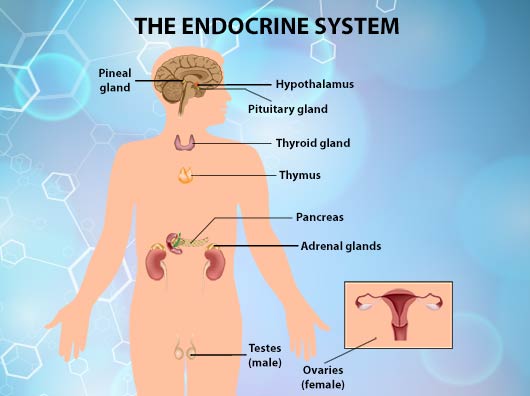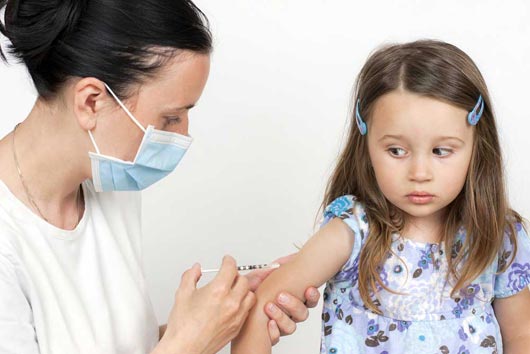
The World Health Organization (WHO) and United Nations warned about this “global threat” in a recent report. It seems no one is safe, no matter where you live, but infants and children are known to be especially vulnerable. Don’t think you can escape by hiding at home, because this danger lurks in every household. I’m talking about endocrine-disrupting chemicals (EDC), those that affect our hormonal system and are linked to a growing list of health problems.
“Endocrine disruptors are chemicals that may interfere with the body’s endocrine system and produce adverse developmental, reproductive, neurological, and immune effects in both humans and wildlife,” states the U.S. National Institute of Environmental Health. In other words, EDCs are linked to a long list of health conditions that include: breast and prostate cancer, endometriosis, infertility, early puberty, diabetes, obesity, asthma, heart disease, hypertension, Alzheimer, Parkinson and ADHD.
THE HUMAN ENDOCRINE SYSTEM
How can these chemicals have such widespread effects on our body? To understand this, we need to take a glimpse at our endocrine, or hormonal, system. The human endocrine system, as explained by WHO, is responsible for controlling a large number of processes in the body, starting before we are born with prenatal processes, such as cell differentiation and organ formation, and including most of the tissue and organ functions throughout adulthood. Hormones are critical for the normal functioning of every organ in our body. EDCs, acting like hormones, can interfere with all these processes.
“Exposure to EDCs could impair the health of our children and their children,” warns WHO in this last report. It is now believed the timing of this exposure is critical, since the effects of EDCs during tissue development, before birth and into early childhood, are most likely irreversible, and lead to health problems over the course of the person’s lifetime. This is one of the main advances in the last 10 years, since WHO’s previous report on environmental chemicals, when the focus was on adult exposure.
Read Related: Children’s Health Issues Every Mom Should Be Aware Of
Another new concern is the combination of EDCs, now believed to have additive effects, even if each chemical is present in harmless low levels, the mixture can have dangerous health results. So what are these hormone-mimicking chemicals that pose such a threat to our future generations? Almost 800 chemicals are suspected to cause adverse health effects, but only a small fraction of the hundreds of thousands out there have been tested, says the international health organization. These are so pervasive, we may be exposed to hundreds of environmental chemicals at any given time through air, water, food and even dermal contact.
FOUND IN EVERY HOME
Many of these are man-made and others are naturally occurring chemicals, including pharmaceuticals, dioxins, pesticides, plasticizers and flame-retardants. Some may sound familiar, because they appear very often in the media, with BPA and phthalates making the most headlines. BPA, or Bisphenol A, is found in plastic bottles, food cans and other food packaging; also in CDs, cell phones, medical devices and water supply pipes. Phthalates are also used in food containers and plastic food wrap, medical equipment, personal care products, children’s toys and child care articles, vinyl floorings and wall coverings.
Chemical manufacturer organizations such as the American Chemistry Council declare both BPA and phthalates have a proven safety record, and possible contamination of food and beverages is well below reference levels set by Federal agencies. The Food and Drug Administration (FDA) however, has acknowledged “some concern” over the results from recent studies and, while conducting their own research to “clarify uncertainties about the risks of BPA”, is taking steps to reduce exposure:
- Restricting BPA from baby bottles and infant feeding cups.
- Supporting efforts to replace BPA in the lining of infant formula cans and other food cans.
Similarly some phthalates—DBP, DEHP and BBP—have been banned for years from children’s toys, and more recently the FDA has recommended the drug industry to avoid them in prescription and nonprescription products.
CHEMICALS IN OUR FOOD
Despite manufacturer’s assurances, two studies published in February on exposure to EDCs in our food uncovered surprising results:
-
Researchers of the UW School of Public Health set out to measure the exposure to BPA and phthalates in the diet by separating participants in the study into two groups. One group received instructions on how to reduce this exposure and the other received a catered diet of organic food carefully prepared to avoid contact with plastics. Interestingly, this last group tested for much higher levels of phthalates and BPA, with the highest concentrations appearing in children. Chemical contamination of several ingredients in the catered diet was found responsible for these elevated concentrations, well above current EPA recommended limits.
-
In what is possibly the first U.S. study to compile an analysis of phthalates in food products, researchers at University of Texas Health confirmed the presence of this EDC in every sample they tested. Pizza, meats and beverages were among the 72 common food products purchased at supermarkets and tested for phthalates. Though the levels discovered were below what EPA considers dangerous, this is a cause for concern, according to the leading investigator in this study, because “these toxins do not belong in our food.”
WHAT CAN WE DO?
While exposure to these chemicals is mostly out of our control, the National Institute of Environmental Health recommends some steps parents can take if concerned over BPA to prevent this:
- Don’t microwave polycarbonate food containers.
- Avoid plastic bottles and containers marked with recycle code 3 or 7, which may contain BPA.
- Reduce the use of canned foods.
- Opt for porcelain, glass and stainless steel containers, especially for hot food and beverages.
Additionally, it is a good idea to discard any old baby bottles and sippy cups if we can’t confirm they are not made with BPA; plus any plastic containers that may be scratched. Also keep in mind older baby toys may contain phthalates, no longer used in newer plastic products. Check the labels of all cleaning products, cosmetics and other personal care products; and choose eco-friendly alternatives whenever possible.
But to really make a difference in protecting our children from these dangerous chemicals it may take a change in regulations, as WHO reminds us in this landmark report, following the example of lead, DDT and other pesticides previously banned by the U.S.











